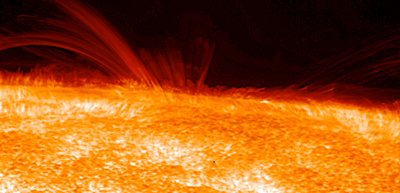 The chromosphere is a structure composed of warm gas that is above the visible surface of the sun and most stars, which is called photosphere. It is transparent in visible light but bright and opaque in strong lines of elements such as hydrogen, helium, calcium and oxygen.
The chromosphere is a structure composed of warm gas that is above the visible surface of the sun and most stars, which is called photosphere. It is transparent in visible light but bright and opaque in strong lines of elements such as hydrogen, helium, calcium and oxygen.
It is about 6,000 miles thick. It is composed of hydrogen which is the reason why it has a visible pink tint and amounts of sodium, helium, iron and calcium. It has three layers that decrease in density and increase in temperature moving outward from the surface of the sun. The lower chromosphere is 10,800°F or 6,000 °C. The middle part has a higher temperature of 90,000°F or 50,000°C while upper layer that is close to the lower corona is as high as 1,800,000°F or 1,000,000°C.
The chromosphere undergoes a phenomenon called solar flares wherein a sudden and intense brightening rises in a couple of minutes and fades away in half an hour to several hours. It also has prominences which are streams of hot gas. They bulge out from the surface that can last for days or even weeks. This can be viewed visibly from the edge of the sun during a solar eclipse.
Chromosphere of the Sun
